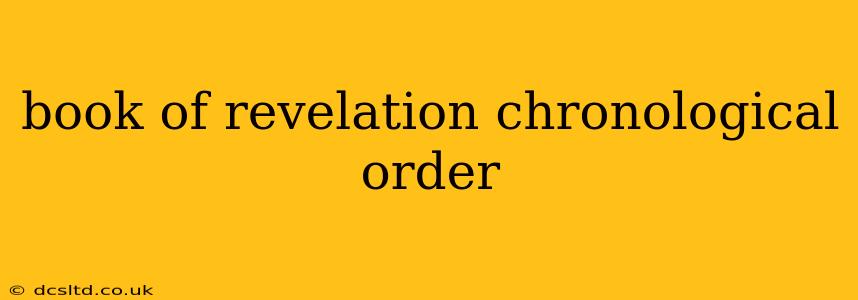The Book of Revelation, the final book of the New Testament, is renowned for its enigmatic symbolism and apocalyptic imagery. Many find it challenging to decipher, and understanding its chronological order is a crucial step in comprehending its message. While a precise, linear timeline is debated among scholars, we can approach a chronological understanding by identifying key events and their probable sequence. It's important to remember that Revelation uses symbolic language, and a purely literal interpretation may miss its deeper meaning.
What is the correct chronological order of the Book of Revelation?
There's no single, universally accepted chronological order of events in Revelation. Interpretations vary widely depending on theological perspectives and hermeneutical approaches. However, a common approach focuses on the sequence of visions and messages presented, recognizing that the book is structured more thematically than chronologically. The book jumps between different time periods and perspectives, presenting a complex tapestry of future events rather than a straightforward timeline.
What are the key events in the Book of Revelation in chronological order?
While a definitive chronological order remains elusive, we can identify key events and place them in a probable sequence based on the text's internal structure and common interpretations:
1. The Prologue: John's Vision and Commission (Revelation 1)
The book begins with John's vision of the risen Christ and his subsequent commissioning to write down what he sees and hears. This sets the stage for the apocalyptic visions to follow.
2. The Seven Churches of Asia Minor (Revelation 2-3)
This section consists of messages addressed to seven specific churches in Asia Minor. While not strictly chronological in a linear sense, these messages seem to be contemporary to John's writing, offering a snapshot of the early church's struggles and triumphs.
3. The Opening of the Seals (Revelation 6-8)
This section depicts a series of judgments unleashed upon the earth as the seven seals of a scroll are opened. These judgments are often interpreted as representing historical and future events. It's crucial to remember that this is likely a symbolic depiction, not a strict timeline of literal events.
4. The Trumpets (Revelation 8-11)
Following the seals, seven trumpets are blown, each heralding further judgments. Similar to the seals, the trumpets are interpreted allegorically, symbolizing both immediate and future consequences of rejecting God.
5. The Two Witnesses (Revelation 11)
Two witnesses prophesy during this period of judgment, ultimately facing martyrdom before their resurrection. Their ministry symbolizes the unwavering testimony of God's people even in the face of persecution.
6. The Woman and the Dragon (Revelation 12)
This section introduces a symbolic depiction of the conflict between good and evil, often interpreted as the struggle between the Church and Satan.
7. The Beast from the Sea and the Beast from the Earth (Revelation 13)
This section describes the rise of two powerful forces that persecute God's people. These beasts are generally understood symbolically, representing oppressive systems and ideologies.
8. The 144,000 and the Harvest (Revelation 14)
This section focuses on the faithful followers of God who remain steadfast in the face of persecution, culminating in a harvest scene symbolic of God's ultimate victory.
9. The Seven Bowls of God's Wrath (Revelation 15-16)
Similar to the seals and trumpets, the pouring out of seven bowls represents a series of divine judgments, escalating the conflict between good and evil.
10. The Fall of Babylon (Revelation 17-18)
This section foretells the destruction of a symbolic Babylon, often interpreted as representing a corrupt and oppressive world system.
11. The Battle of Armageddon (Revelation 19)
This is a climactic battle between good and evil, ultimately resulting in the defeat of Satan and his forces.
12. The Millennium and the Final Judgment (Revelation 20-22)
This section describes a thousand-year reign of Christ (the Millennium), followed by the final judgment and the establishment of the New Heaven and New Earth.
Are there different interpretations of the chronological order?
Absolutely. Different schools of thought offer varying interpretations of the Book of Revelation's timeline. Some see it as primarily focusing on the early church's struggles and triumphs, while others view it as a prophecy spanning from the first century to the end of history. Preterist interpretations focus on the fulfillment of prophecies within the first century, while futurist interpretations project these events into the future. Idealist interpretations view the book as a timeless allegory of the ongoing struggle between good and evil.
Understanding the Book of Revelation requires careful consideration of its symbolic language and various interpretations. While a strict chronological ordering remains debated, understanding the sequence of visions and their likely thematic connections provides a more coherent grasp of its powerful message. It is advisable to consult various scholarly resources and engage in thoughtful reflection to deepen your understanding.
